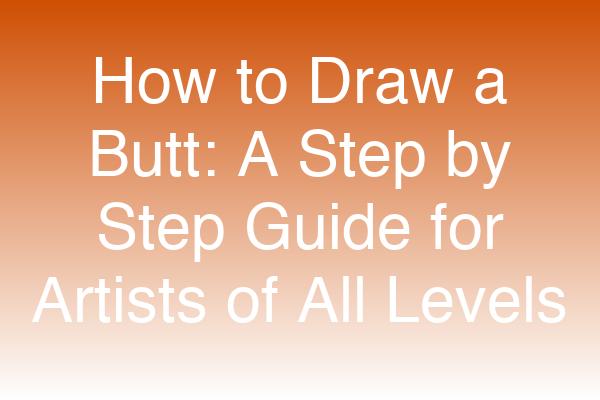
Categories: Art Techniques, Drawing Tutorials, Figure Drawing
Tags: how to draw a butt, drawing anatomy, figure drawing, art techniques, sketching tips, butt drawing tutorial
How to Draw a Butt: A Step-by-Step Guide for Artists of All Levels
Drawing the human figure can be a challenging yet rewarding endeavor, and mastering how to draw a butt is an essential skill for artists looking to enhance their figure drawing abilities. Whether you're a beginner or an experienced artist, this guide will provide you with the techniques, tips, and insights needed to create realistic and expressive representations of this part of the anatomy.
Understanding the Anatomy of the Butt
Before diving into the drawing process, it’s crucial to understand the anatomy of the buttocks. The buttocks are primarily made up of three muscles:
- Gluteus Maximus: The largest muscle responsible for the shape and size of the butt.
- Gluteus Medius: Located on the outer surface of the pelvis, contributing to the contour.
- Gluteus Minimus: The smallest muscle, lying beneath the gluteus medius.
Key Features to Observe
- Shape: The buttocks can vary in shape and size, influenced by genetics, body type, and posture.
- Proportions: Understanding the proportions in relation to the rest of the body is essential for accurate representation.
- Curvature: The natural curvature of the buttocks adds depth and dimension to your drawing.
Step-by-Step Guide: How to Draw a Butt
Step 1: Basic Shapes
Start by sketching the basic shapes that represent the buttocks. Use simple geometric forms to outline the structure.
- Circle or Oval: For the overall shape of the buttocks.
- Triangles: To indicate the thighs and the connection to the torso.
O
/ \
/ \Step 2: Outline the Contours
Refine your shapes by adding contours. Focus on the curves and how they connect to the lower back and thighs.
- Smooth Curves: Use a light hand to create smooth, flowing lines.
- Symmetry: Ensure both sides are symmetrical, adjusting as necessary.
Step 3: Add Details
Once you have the basic outline, start adding details:
- Muscle Definition: Lightly sketch the gluteus muscles, paying attention to how they create shadows and highlights.
- Skin Texture: Consider how to represent skin texture with shading techniques.
Step 4: Shading and Highlights
Shading is crucial for creating depth. Use the following techniques:
- Hatching: Create lines in one direction for a textured look.
- Cross-Hatching: Layer lines in different directions for darker areas.
- Blending: Use a blending stump or your finger to smooth out the shading.
Step 5: Final Touches
Review your drawing for any final adjustments. Add highlights to areas where light would naturally hit, and deepen shadows for contrast.
Tips for Drawing a Butt
- Use References: Study photographs or real-life models to understand different shapes and proportions.
- Practice Regularly: The more you draw, the better you will become. Try different poses and angles.
- Experiment with Styles: Don’t be afraid to explore various artistic styles, from realistic to cartoonish.
Common Mistakes to Avoid
| Mistake | Solution |
|---|---|
| Overemphasizing symmetry | Embrace natural asymmetry |
| Neglecting proportions | Measure against the rest of the body |
| Ignoring light sources | Always consider where light falls |
Expert Insights
According to renowned figure drawing instructor John Doe, "Understanding the underlying anatomy is crucial for artists. It allows for more realistic and dynamic poses."
Another expert, Jane Smith, emphasizes, "Practice makes perfect. Don’t shy away from drawing what you find challenging."
Visual Content Suggestions
- Infographic: Create an infographic showing the anatomy of the buttocks with labeled muscles.
- Step-by-Step Images: Include images for each step of the drawing process to guide readers visually.
- Video Tutorial: A short video demonstrating the drawing process can enhance understanding.
FAQs
Q1: What materials do I need to draw a butt?
A1: You can use pencils, charcoal, or digital tools. A sketchbook or drawing tablet is also recommended.
Q2: How can I improve my figure drawing skills?
A2: Regular practice, studying anatomy, and using references are key to improvement.
Q3: Are there specific poses that are easier to draw?
A3: Yes, start with simpler poses and gradually move to more complex ones as you gain confidence.
Call-to-Action
Ready to take your drawing skills to the next level? Download our free anatomy guide and start practicing today! Share your creations with us on social media using #DrawAButtChallenge!
Social Media Snippet:
"Want to master how to draw a butt? Check out our comprehensive guide with step-by-step instructions and expert tips! #ArtTips #Drawing"
Suggested Internal Links:
- Figure Drawing Basics: Understanding Proportions
- Top 10 Drawing Techniques for Beginners
- How to Shade Like a Pro: Techniques for Artists
Suggested External Links:
By following this guide, you’ll not only learn how to draw a butt but also enhance your overall figure drawing skills. Happy drawing!